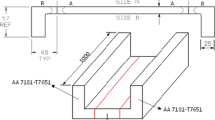Abstract
This study aims to contribute to the development of performance-based quality control criteria, and fatigue design provisions for friction stir welded (FSW) joints used in structural applications. Fatigue tests have been conducted under tension loading on thick AA6061-T6 aluminum plates fabricated using friction stir welding. Fatigue stress-life (S–N) curves have been compared to fatigue design curves (ADM and IIW) available in international design codes. Defect tolerances in existing FSW standards (AWS and ISO) have been reviewed. Results show that an axial (linear) misalignment defects of the order of 10% of the plate’s thickness in size and a channel (wormhole) defect with the largest dimension of the order of 9% of the plate’s thickness provide an average fatigue strength of 81 MPa and 78 MPa respectively as compared to 103 MPa for a properly welded joint.









Similar content being viewed by others
References
CSA Group (2017) S157–2017/S157.1–2017: Strength design in aluminum. Canadian Standards Association (CSA), Toronto, Canada
St-Georges L, Kiss LI (2018) Friction stir welding: principles and applications, 1st edn. CQRDA - PRAL, Chicoutimi, Canada
Mishra RS, Ma ZY (2005) Friction stir welding and processing. Mater Sci Eng R 50(1–2):1–78
Walbridge S, de la Chevrotière A (2012) Opportunities for the use of aluminum in vehicular bridge construction. Maadi Group, Montreal, Canada
Guo S, Shah L, Ranjan R, Walbridge S, Gerlich A (2019) Effect of quality control parameter variations on the fatigue performance of aluminum friction stir welded joints. Int J Fatigue 118:150–161
Dickerson T, Przydatek J (2003) Fatigue of friction stir welds in aluminium alloys that contain root flaws. Int J Fatigue 25(12):1399–1409
Fowler S, Toumpis A, Galloway A (2015) Fatigue and bending behaviour of friction stir welded DH36 steel. Int J Adv Manuf Technol 84(9–12):2659–2669
Ranjan R, de Oliveira Miranda AC, Guo S, Walbridge S, Gerlich A (2019) Fatigue analysis of friction stir welded butt joints under bending and tension load. Eng Fract Mech 206:34–45
American Welding Society (2016) AWS D17.3/D17.3M:2016 - Specification for friction stir welding of aluminum alloys for aerospace applications. American Welding Society (AWS), Miami, Florida
ISO 25239–5:2011 (2011) Friction stir welding — aluminium — Part 5: Quality and inspection requirements. International Organization for Standardization (ISO), Geneva, Switzerland
CSA Group (2018) W59.2–18: welded aluminum construction. Canadian Standards Association (CSA), Toronto, Canada
AA ADM-2015 (2015) Aluminum design manual part I: specification for aluminum structures. The Aluminum Association, Arlington, Virginia
Hobbacher AF (2016) Recommendations for fatigue design of welded joints and components, 2nd edn. Springer International Publishing IIW-2259-15, Switzerland
EN 1999–1–3:2007/A1 (2007) Eurocode 9: design of aluminium structures - Part 1–3: structures susceptible to fatigue. European Committee for Standardization, Bruxelles, Belgium
Haagensen PJ, Midling OT, Ranes M (1995) Fatigue performance of friction stir butt welds in a 6000 series aluminum alloy. Trans Eng Sci 8:225–237
Miranda ACDO, Gerlich A, Walbridge S (2015) Aluminum friction stir welds: Review of fatigue parameter data and probabilistic fracture mechanics analysis. Eng Fract Mech 147:243–260
Pietras A, Weglowski MS (2014) Imperfections in FSW joints and NDT methods of their detection. Biuletyn Instytutu Spawalnictwa 2:23–32
Guo S (2018) Fatigue behavior of aluminum friction stir welds under highway bridge loading conditions. Civil and Environmental Engineering, University of Waterloo, MASc
Ericsson M, Jin L, Sandstrom R (2007) Fatigue properties of friction stir overlap welds. Int J Fatigue 29(1):57–68
Uematsu Y, Tokaji K, Shibata H, Tozaki Y, Ohmune T (2009) Fatigue behaviour of friction stir welds without neither welding flash nor flaw in several aluminium alloys. Int J Fatigue 31(10):1443–1453
Hovanski Y (2018) Automated production of aluminum tailor-welded blanks. In: 12th International Symposium on Friction Stir Welding. TWB Company, Saguenay, Canada
Zhou C, Yang X, Luan G (2006) Effect of kissing bond on fatigue behavior of friction stir welds on Al 5083 alloy. J Mater Sci 41(10):2771–2777
Ranjan R (2019) Probabilistic strain-based fracture mechanics analysis of weldments. Civil Engineering, University of Waterloo, PhD
Ranjan R, Walbridge S, Shah L, Gerlich A (2020) Probabilistic fracture mechanics analysis of friction stir weld fatigue performance. Light Metal Welding 58(Supplement):72s–76s
Acknowledgements
The authors are grateful to the Natural Sciences and Engineering Research Council of Canada (NSERC), the Aluminium Association of Canada (AAC) and the Aluminium Research Center (REGAL) for their financial support. The authors also wish to thank the Centre de Soudage par Friction Malaxage de l’UQAC (CSFM-UQAC) for the use of its welding equipment and time. The authors wish to acknowledge Groupe Canmec Inc. for its help and partnership. Assistance from the technical staff at the University of Waterloo, CURAL, and CSFM-UQAC is also acknowledged.
Author information
Authors and Affiliations
Corresponding author
Ethics declarations
Conflict of interest
The authors declare no competing interests.
Additional information
Publisher's note
Springer Nature remains neutral with regard to jurisdictional claims in published maps and institutional affiliations.
Recommended for publication by Commission XIII - Fatigue of Welded Components and Structures.
Rights and permissions
Springer Nature or its licensor (e.g. a society or other partner) holds exclusive rights to this article under a publishing agreement with the author(s) or other rightsholder(s); author self-archiving of the accepted manuscript version of this article is solely governed by the terms of such publishing agreement and applicable law.
About this article
Cite this article
Fleury, A., Ranjan, R., Shah, L.H. et al. Fatigue performance of thick 6061-T6 aluminum friction stir welded joints with misalignment or channel defects. Weld World 67, 707–720 (2023). https://doi.org/10.1007/s40194-022-01430-1
Received:
Accepted:
Published:
Issue Date:
DOI: https://doi.org/10.1007/s40194-022-01430-1




